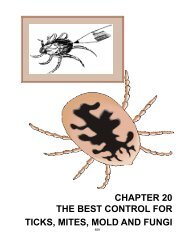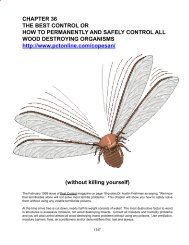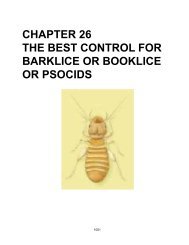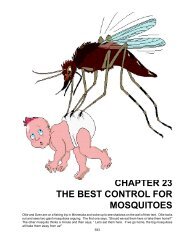chapter 16 the best control for human lice and scabies
chapter 16 the best control for human lice and scabies
chapter 16 the best control for human lice and scabies
You also want an ePaper? Increase the reach of your titles
YUMPU automatically turns print PDFs into web optimized ePapers that Google loves.
meat tenderizer, all things to which <strong>lice</strong> are sensitive. (Be sure you are not sensitive too!) Salt water will also<br />
kill <strong>lice</strong>, but will not remove <strong>the</strong> nits. Hair dryers will kill <strong>lice</strong> <strong>and</strong> nits in 30 minutes or less.<br />
Close adaptation locks head <strong>lice</strong> into <strong>the</strong> <strong>human</strong> scalp in several ways. First, louse claws grasp <strong>human</strong> hair so<br />
firmly that <strong>the</strong>y do not fall or w<strong>and</strong>er out of it <strong>and</strong> yet <strong>the</strong>y can crawl fast. Second, head <strong>lice</strong> suck blood by grasping<br />
<strong>the</strong> scalp with tiny hooks that surround <strong>the</strong>ir mouth, <strong>and</strong> painlessly pierce <strong>the</strong> skin with slender stylets. (Head<br />
<strong>lice</strong> feed several times a day but do not engorge <strong>the</strong>mselves.) Most importantly, head <strong>lice</strong> neatly glue <strong>the</strong>ir eggs<br />
(called nits) to <strong>the</strong> hair shaft, usually within ¼ inch of <strong>the</strong> scalp. The tiny, pearl-like eggs (<strong>the</strong>y look like miniature<br />
wax tear drops) stick alongside <strong>the</strong> hair so tightly that <strong>the</strong>y can be dislodged only by being torn from <strong>the</strong>ir neat<br />
sleeve of biological glue by fingernails or a metal <strong>lice</strong> comb or Safe Solutions Enzyme Cleaners. Usually nits<br />
found fur<strong>the</strong>r away from <strong>the</strong> scalp than ½ inch will have already hatched; what is found is <strong>the</strong> empty shell which<br />
remains attached. The easiest way to remove cemented eggs is to cut <strong>the</strong>m out or try to soak <strong>the</strong> hair in vinegar<br />
or baby oil or in diluted Lice R Gone ® <strong>for</strong> 10 - 30 minutes; <strong>the</strong>m comb out with a metal nit or flea comb. If any<br />
nits still remain, apply Tangles R Gone ® Hair Conditioner <strong>and</strong> recomb. How head <strong>lice</strong> are spread from child to<br />
child o<strong>the</strong>r than crawling is not well known, but <strong>the</strong>y do not jump off or freely w<strong>and</strong>er onto coat collars or hats,<br />
since <strong>the</strong>y are restricted to <strong>human</strong>s with a scalp surface temperature of around 80 o F. or a little more, but headto-head<br />
contact <strong>and</strong> sharing of clothing, hair ornaments <strong>and</strong> grooming materials are thought to be <strong>the</strong> normal<br />
routes of invasion. Temperature preference <strong>and</strong> perhaps humidity is so critical that <strong>lice</strong> easily die at elevated<br />
temperatures <strong>and</strong> from excess salty perspiration - so sauna! Conversely, at lower surface temperatures (about<br />
50 o F.) <strong>lice</strong> become torpid <strong>and</strong> do not move or feed. A reasonable speculation is that head louse nymphs hatch<br />
from nits on hair shafts snatched by brushes <strong>and</strong> deposited on knit hats. The tiny nymphs <strong>the</strong>n move toward<br />
<strong>the</strong> warmth of <strong>the</strong> next head covered by <strong>the</strong> cap or brushed by <strong>the</strong> brush. This normally limits transmission<br />
to siblings that have <strong>the</strong>ir hair brushed with a “family brush” or children who share knit hats or hair brushes of<br />
friends. Get your own brush <strong>and</strong> cap <strong>and</strong> become “selfish”.<br />
Louse infestations are often discovered by school teachers who are watching <strong>for</strong> <strong>the</strong> signs of itching heads<br />
<strong>and</strong>/or frequent scratching, but classroom neighbors are not as likely to be infested as are bro<strong>the</strong>rs <strong>and</strong> sisters<br />
or close friends that sleep over with head-to-head contact or share combs <strong>and</strong> hair brushes <strong>and</strong>/or head gear.<br />
(American) head <strong>lice</strong> have been shown by surveys in several large eastern cities to infest <strong>the</strong> heads of Caucasian<br />
<strong>and</strong> Oriental children but <strong>the</strong>y very seldom infest those of African Americans (whose hair may be more oily<br />
<strong>and</strong> flattened). If you are using Lice R Gone ® - wash your hair again in 5 - 10 days with <strong>the</strong> same protocol, if<br />
necessary. Be sure not to confuse nits with hair debris such as irregularly-shaped clumps of d<strong>and</strong>ruff stuck to<br />
<strong>the</strong> hair shaft or elongated segments of d<strong>and</strong>ruff encircling <strong>the</strong> hair shaft - that are easily dislodged. You have<br />
to get rid of all <strong>the</strong> nits on <strong>the</strong> hair shafts to prevent a reinfestation; use a bright light, a magnifying<br />
glass <strong>and</strong> metal (nit/flea) comb.<br />
South Florida kids have been kept out of school 68 days at a time per Terry Meinking, B. A. at a Hyatt Regency<br />
meeting in Tampa on 5/4/99. For every 4 children found to be infested with head <strong>lice</strong> by <strong>the</strong> comb method, only<br />
1 child was found to be infested by <strong>the</strong> visual method. The punctures <strong>the</strong> <strong>lice</strong> make while feeding <strong>and</strong> people<br />
make by scratching will transfer bacterial infections, which explains <strong>the</strong> statement “feeling lousy.” Vaseline, which<br />
is a mix of mineral oil <strong>and</strong> wax, can be applied 5 times a day <strong>for</strong> a week to eyelashes if eyelashes are found to<br />
be infested with head or crab <strong>lice</strong>, but Vaseline ® is very flammable!<br />
Head Louse Control - The diagnosis can be difficult as <strong>the</strong> insects tend to hide among <strong>the</strong> hair shafts in<br />
response to light or disturbance. Use a comb with parallel teeth spaced 0.3 mm or less apart <strong>and</strong> examine under<br />
a bright light or in sunlight. A study in Israel found 70% of infested children had only 1 - 10 <strong>lice</strong>. The real <strong>control</strong><br />
problems are <strong>the</strong> nits that remain on <strong>the</strong> hair shaft (even if no longer on <strong>the</strong> head) <strong>and</strong> can hatch <strong>and</strong> “reinfest”<br />
<strong>for</strong> up to 10-20 days later, so soak your head with olive oil or baby oil overnight <strong>and</strong> cover with a shower cap;<br />
<strong>the</strong>n use a metal nit comb <strong>and</strong> <strong>the</strong>n shampoo with a conditioner in <strong>the</strong> a.m. or simply wash your hair with Lice R<br />
Gone<br />
792<br />
® Shampoo <strong>for</strong> 10 minutes or until <strong>the</strong> nits pull away, <strong>and</strong> <strong>the</strong>n rinse off <strong>the</strong> enzyme solution, <strong>lice</strong> <strong>and</strong> nits.<br />
If any nits remain, apply your Tangles R Gone Hair Conditioner <strong>and</strong> recomb. When combing out nits, work with<br />
small sections (1” or smaller) of hair. Keep <strong>the</strong> metal comb’s teeth deep into <strong>the</strong> hair from <strong>the</strong> scalp to <strong>the</strong> end<br />
of <strong>the</strong> hair. Clean your louse comb after each stroke in dilute enzyme cleaners or hot soapy water. Keep <strong>the</strong><br />
hair moist (use a spray bottle of diluted enzymes). Adding baby or olive oil or vinegar <strong>and</strong>/or Tangles R Gone ®<br />
Hair Conditioner may make <strong>the</strong> combing of nits out of <strong>the</strong> hair easier. Only after trying all of <strong>the</strong> alternatives,<br />
<strong>and</strong> <strong>the</strong>n only as a last resort, <strong>the</strong>re are several over-<strong>the</strong>-counter (OTC) poison preparations that can be used<br />
to try to eliminate louse infestations, but we believe <strong>the</strong>y are all equally ineffective <strong>and</strong> dangerous even when









